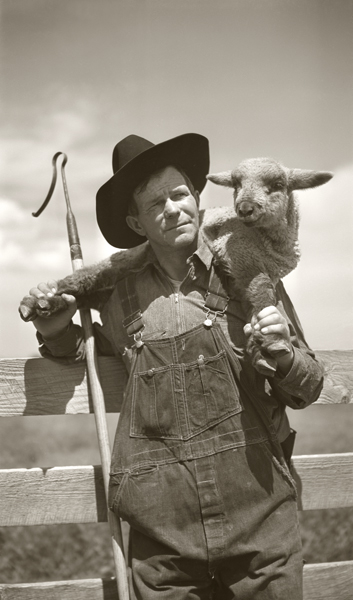 |
The Haberstroh Collection documents the Harvat Ranch in Montana's Paradise Valley, one of the largest sheep ranching operations in southwest Montana. From 1915 to the 1950s, John Haberstroh photographed all aspects of the ranch including the sheep hearders, shearing, lambing, and the yearly move to summer pasture. Haberstroh's efforts produced a collection of over 900 original negatives of exceptional aesthetic and technical quality. The collection was donated to the museum in 1987. | ||
|
John Haberstroh (1878-1961) - John Haberstroh was born on January 12, 1878 in Iowa City, Iowa. One of six children, John attended school in Iowa City and graduated from high school in 1896. In 1900 John visited his older sister Elizabeth (Mrs. John H. Harvat Sr.) on the Harvat ranch near Livingston, Montana and was so taken with the country that he decided to make it his home. Upon his arrival in Montana, John Haberstroh got a job working for the Sax and McCue (later Sax and Fryer) stationary and variety store. He worked there until 1925, when he bought a controlling interest in the store from Mr. Sax. In 1926 John married Grace Smith, a local school teacher, and the couple had two children: Chad in 1927 and Mary Kay in 1933. John first began making photographs in 1915, using a folding Kodak model 3A (post card camera), a camera he used exclusively for over thirty years. His growing talent and knowledge of photography led to his becoming manager of the photography department for Sax and Fryers in the early twenties and through store displays John began to successfully market his photographs. During this same time, John began photographing the operations of his brother-in-law's sheep ranch, a project that he would eventually devote over thirty years to. John Haberstroh achieved a mastery of the photographic craft through much experimentation with processing, printing and a tireless interest in improving his photographs. Also an avid hunter and outdoorsman, John loved the time he spent on the ranch or in the mountains following the herders and documenting their lives. Often accompanied by his son Chad, they would ride horseback to the high summer pastures and spend their days searching for the best lighting and vantage point for his photographs. John sold hundreds of his photographs through the Livingston store and was published in numerous newspapers and magazines throughout his life. He sold his interest in Sax and Fryers and retired in 1945. John Haberstroh continued to make photographs until 1956. He died September 4, 1961.
|
|||
Internet highlights
- Casino Crypto
- Casinos Not On Gamstop
- Gambling Sites Not On Gamstop
- Casinos Not On Gamstop
- Casino Non Aams Legali
- Non Gamstop Casino UK
- Sites Not On Gamstop
- Non Gamstop Betting Sites UK
- Casino Not On Gamstop
- Trusted Non Gamstop Casinos
- Casino Sites Not On Gamstop
- Non Gamstop Casinos
- Non Gamstop Casino UK
- Casino Not On Gamstop
- Betting Sites UK
- Slot Sites
- Casino En Ligne
- Casino En Ligne
- Best Non Gamstop Casinos
- Casino Sites Not On Gamstop
- UK Casinos Not On Gamstop
- Casino Non Aams Sicuri
- UK Online Casinos Not On Gamstop
- Migliori Siti Casino Online
- Casino Non Aams